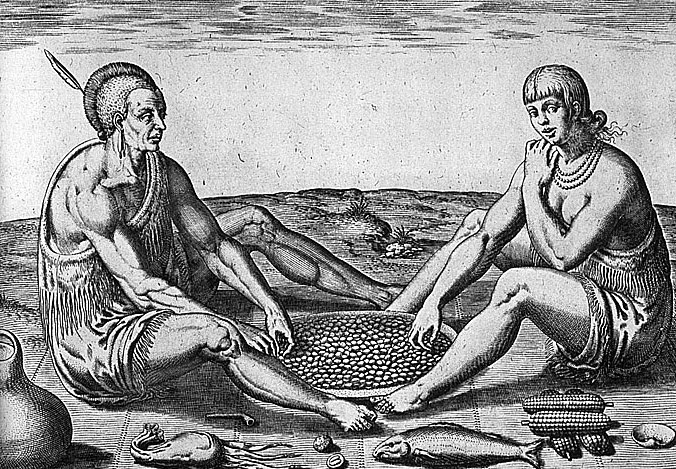Study Guide Social Hierarchies

Table of Contents
Gift Exchange
Reciprocity, gifts, and exchange were fundamental ways that Wampanoags and other Algonquians established social status and maintained relationships. Chance and ritual meetings between confederacies and bands (as well as inter-confederate alliances themselves) were regulated and ordered through a system of reciprocity that included trade, gift-exchange, hospitality to "outsiders," and intermarriage (1). These exchanges between Algonquians can be seen as providing guidelines for the cross-cultural exchange with the English: George Hamell has argued that Algonquian willingness to trade was due, in part, to notions of alliance and reciprocity. Encounters with non-residents, whether they were “mythical” beings or from other confederacies, were marked by a ritual exchange of goods, power, and knowledge (Hamell). Reciprocity maintained order and social cohesion with other people and the world itself. This notion of reciprocity defined the way Algonquians attempted to assimilate the English into their system of relations, as well how the English were incorporated into the Algonquian worldview.
 Anthropologists and historians have suggested that Algonquian relationships between other humans, as well as with plants, animals, and spirits, were based on a notion of reciprocity not prominent in the English system (see Salisbury 1982; Hamell). In his work on gift exchange, Marcel Mauss defines reciprocity as the "complex series of exchanges between individuals and villages" whereby "War, isolation, and stagnation" are replaced by "alliance, gift, and commerce" (Hulme 147-48, quotes and discusses Mauss). While useful, this definition is somewhat inaccurate for Algonquians in two significant ways: one, it tends to see reciprocity as solely occurring between humans, and two, it ignores the larger cosmological significance of these exchanges by focusing on their material aspects.
Anthropologists and historians have suggested that Algonquian relationships between other humans, as well as with plants, animals, and spirits, were based on a notion of reciprocity not prominent in the English system (see Salisbury 1982; Hamell). In his work on gift exchange, Marcel Mauss defines reciprocity as the "complex series of exchanges between individuals and villages" whereby "War, isolation, and stagnation" are replaced by "alliance, gift, and commerce" (Hulme 147-48, quotes and discusses Mauss). While useful, this definition is somewhat inaccurate for Algonquians in two significant ways: one, it tends to see reciprocity as solely occurring between humans, and two, it ignores the larger cosmological significance of these exchanges by focusing on their material aspects.
Reciprocity, it seems, was key to all Wampanoag relationships and was a means of maintaining balance and order in the world around them. Hamell emphasized that Algonquians inhabited a social world based on kinship ties to humans and non-humans rather than an "inorganic" natural world (Hamell 68). These kinship ties meant people had consequent social responsibilities to all lifeforms and objects (Hamell 68). Relationships--and the social order itself--were maintained through rituals comprised of knowledge, songs, procedures, and "precious gifts" (Hamell 68). To renege on these obligations and the rituals that sustained them was to threaten the social order, invoke "divine displeasure," and risk having life-sustaining gifts withheld (Jones 186; Salisbury 35). As long as relations were desired, such exchanges were an ongoing phenomenon, rather than a "one-shot-deal." In her work on English and Algonquian Treaties, Dorothy Jones emphasizes that, "In Indian diplomatic traditions, treaties were not merely temporal agreements. They were sacred collective obligations, to be broken only under peril of divine displeasure" (Jones 186). Not completing gift-exchanges and their accompanying rituals meant disrupting the balance of relationships; similarly, properly addressing, treating, and respecting nature and other humans was essential to the reciprocal relationship (Salisbury 35-36). Thus, unlike the English who largely saw material possessions as a route to earthly power, for Algonquians "wealth" (wampum and possessions) connoted "physical, spiritual, and social well-being" (Hamell 67). While accumulating wealth was a form of assurance of well-being or medicine, giving away wealth to the living and the dead also served a similar purpose (Hamell 68). Gifts helped confirm and maintain existing relationships, as well as cement new ones. In sum, English perceptions of trade were in many ways fundamentally different from that of New England Algonquians.
The differences between Algonquian and English views on exchange and reciprocity undoubtedly effected their understanding of “charity” and relief to the poor. British exchanges tended to be unequal and based on perceived social status. Those of higher status were expected to "govern and care for their inferiors" and in return lower classes were expected to provide labor, obedience, and respect (Amussen 134). Indeed, the English often separated the poor into the “worthy poor” and “unworthy poor”: the worthy poor were poor through no fault of their own, while the unworthy poor actively contributed to their own down fall (Lee 572). In a theocracy like colonial New England, sinful behavior clearly contributed to one’s downfall while saintly behavior proved one’s worthiness. Notably, many of the “worthy poor” on Experience Mayhew's “Record of Disbursements Given to the Indian Poor at Martha's Vineyard” (1755) come from long-standing Christian families. How the receiving families interpreted this “charity” however is another question altogether. As Katherine Hermes notes, New England Algonquians’ notion of reciprocity effected their understanding of justice in the colonial courts: “For Algonquians involved in disputes with Europeans…they expected that, if they had to pay a fine or damages, the European litigant would have to pay as well. The idea was that the sides exchanged something, so that in the end both parties had a material and a psychological ‘gift.’” (Hermes 127). Conflicting understandings of the meaning and role of reciprocity continued to impact white and Wampanoag relationships throughout the colonial era.
Notes
(1) Kathleen March notes that intermarriage also tied bands together within a confederacy: "On attaining manhood, a Narragansett generally took a wife from a different band, paying her parents a mutually agreeable sum. Marriages were generally monogamous" (March 42). Folklore from the region emphasizes the importance of properly maintaining these relationships (Simmons 1986: 127-28).